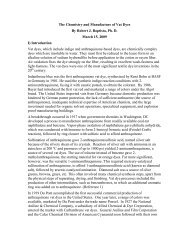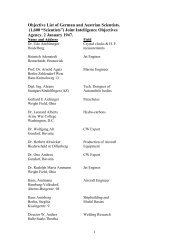International Dyestuff Industry - ColorantsHistory.Org
International Dyestuff Industry - ColorantsHistory.Org
International Dyestuff Industry - ColorantsHistory.Org
Create successful ePaper yourself
Turn your PDF publications into a flip-book with our unique Google optimized e-Paper software.
Lecture, published in 1896. [25] His processes made possible dye manufacture on a high<br />
tonnage scale, and encouraged moves towards unit operations. This became critical to the<br />
continued growth of the dye and, later, organic chemical industries.<br />
In the development of the alizarin plant, William Perkin worked closely with his brother and<br />
partner Thomas Dix Perkin. They first investigated the supply of suitable quantities of the<br />
starting material, anthracene, a minor component of pitch, the non-volatile residue from the<br />
distillation of coal tar.<br />
William Perkin recorded that in 1855 he had employed iron pots in order to distill coal tar<br />
pitch, from which anthracene had been obtained, for his research at the Royal College of<br />
Chemistry. In the factory there were a number of iron retorts, and with them several tons<br />
of pitch were also distilled. The solid crude anthracene was obtained from the distillate on<br />
standing, then placed in canvas bags so that residual oil could be pressed out and drained<br />
off. In July 1869, the first hydraulic press was introduced to make this work easier and<br />
more efficient.<br />
The crude material was then washed with coal tar naphtha and redistilled from one retort<br />
into another via a hot connecting pipe. The resulting solid mass, a mixture of hard yellow<br />
crystals and powder, represented no more than one per cent of the starting pitch.<br />
The Perkin brothers were aware that anthracene "could also be obtained from the last<br />
runnings of tar stills from which it crystallized on cooling." [26]<br />
Having mastered the art of anthracene separation, Thomas then visited major coal tar<br />
distilleries to instruct the distillers in the art of anthracene extraction, "promising to take all<br />
they could make, and in this way a sufficient supply for our requirements was soon obtained<br />
of all sorts of qualities, some being not much thicker than pea soup, from the imperfect way<br />
in which it was drained "<br />
Assessing the quality of the hydrocarbon required considerable ingenuity, and drew on the<br />
efforts of many chemists during the 1870s: "The value of the anthracene was estimated by<br />
washing with carbon disulphide, afterwards alcohol was used, but for our purposes we all<br />
along used an anthraquinone test. This method was worked out more perfectly afterwards<br />
on the Continent, and made a practical test for both buyer and seller; but at the time I am<br />
writing tar distillers were not sufficiently educated in such matters to use any but very<br />
simple tests." [27]<br />
The anthracene which arrived from the distillers was in a thick pasty form packed in casks.<br />
This material was then placed between thick linen sheets and subjected to the hydraulic<br />
presses. However, as Perkin noted, once distillers began to extract all they could, the<br />
quality of the delivered material deteriorated rapidly, and "any article tested by alcohol, and<br />
showing a melting point of 190°C was sold as anthracene." [28] Oxidation to the quinone<br />
became excessively expensive since the reagents were also consumed by acting on other<br />
materials present with the anthracene. This was eventually overcome by a subsequent<br />
purification step in which the crude anthracene was distilled over caustic potash (potassium<br />
hydroxide), that removed unwanted constituents of the mixture. (These were not<br />
understood until the presence of carbazol was demonstrated by Graebe in 1880).<br />
The fully developed anthracene production plant is shown in Figure 1, taken from Perkin's<br />
1879 historical account. Operations commenced with grinding under edge rollers in a<br />
shallow tray, shown to the bottom right of the figure. The ground material was then carried<br />
to the top of the building by means of a hoist and deposited in the cylinders, bb, half filled<br />
with petroleum spirit (which was used instead of naphtha). Some 1,500 to 1,800 lbs. of<br />
crude anthracene were mixed with around 300 gallons of petroleum spirit at every charge.





